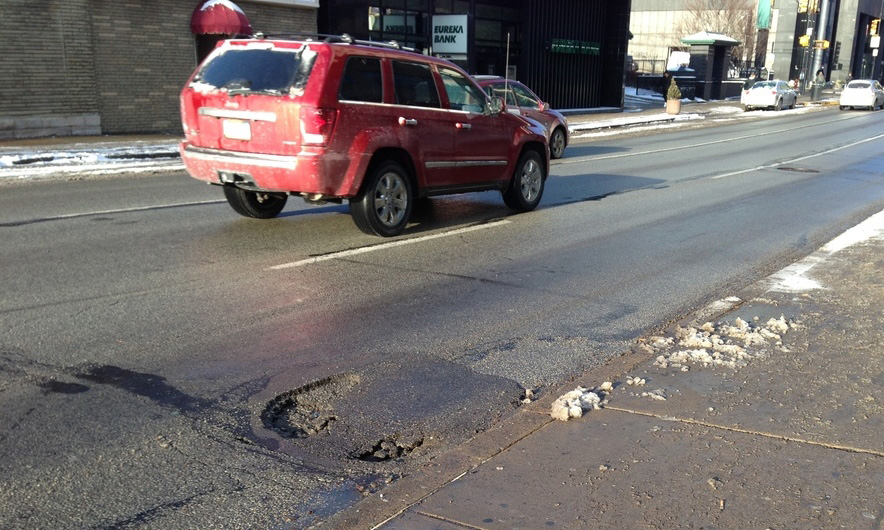With the bite of winter come bumpy rides as pothole season takes over Pittsburgh’s roads, many of which are already in need of considerable repair, the latest pavement condition data suggest.
But as rough as our roads are, they’re not as bad as those in many parts of sun-bleached California.
Greater Pittsburgh’s road condition ranking has improved in recent years among the 15 Pittsburgh Today benchmark regions. Yet, 48 percent of roads in southwestern Pennsylvania remain in mediocre or poor condition, according to a recent report published by TRIP, a nonprofit transportation research organization.
TRIP used 2011 Federal Highway Administration data to evaluate pavement conditions of roads across the United States. Ride quality was based on the International Roughness Index (IRI) and the Present Serviceability Rating (PSR), two indices used to assess pavement smoothness. Roads are classified as being in poor, mediocre, fair or good condition based on the index score. Roads with an IRI score below 95, for example, offer a good ride quality. Roads with an IRI score greater than 170 are in poor condition and their ride quality is considered unacceptable.
Pittsburgh drivers aren’t the only ones dealing with significant stretches of rough road. In fact, among our 15 benchmark regions, Pittsburgh has the fifth lowest percentage of mediocre or poor roads. Baltimore, Philadelphia and Milwaukee are among the regions where motorists find more rough roads. Denver drivers have the bumpiest ride with 78 percent of the region’s roads in mediocre or poor condition.
And 54 percent of the nation’s urban roads – including interstates, freeways and other arterial routes, such as limited-access freeways and city streets – have pavements that are in poor or mediocre condition.
The poorest roads in the nation are found all over the map. In the Los Angeles-Long Beach-Santa Ana area, 64 percent of major roads are in poor condition, which is the highest share of lousy roads in the nation. And many other cities in California, such as San Francisco-Oakland and San Diego, fall into the top twenty urban areas with poor pavement conditions. Other urban areas with a high percentage of poor roads range from Tucson to Milwaukee to Oklahoma City. The Pittsburgh area falls right at the national average with 27 percent of roads in poor condition.
Several factors influence pavement conditions. “The first factor is the level of investment, the amount of money being spent to build the system and to be able to maintain it,” says Frank Moretti, director of Policy and Research at TRIP. “The quality of the initial construction, such as the types of materials, are certainly a critical factor.
“Then there is the amount of traffic. That’s why you see roads in California in such distress because they are some of the most heavily traveled in the country, and there is also a heavy increase in large, heavy truck travel. Then there are weather conditions, environmental conditions. Freeze-thaw cycles are an issue.”
Driving on roads in poor condition can be costly to drivers. When roads deteriorate, motorists are saddled with additional operating costs. The Highway Development and Management Model is the most common method used to calculate the impact of road conditions on vehicle operating costs. Based on 2011 data, drivers in the Pittsburgh area paid $432 annually for car maintenance and repair due to poor road conditions, which despite road improvements is higher than in 2008.
Additional vehicle operating costs due to road conditions is low in Pittsburgh compared to most of the benchmark regions. While Richmond area drivers only tacked on $353 a year, those in the Milwaukee region spent $700 more on additional operating costs.
The recent transportation bill adopted in Pennsylvania promises to stabilize funding and provide additional dollars for road and bridge improvements. But uncertainty is on the horizon for federal transportation funds critical to improving regional infrastructure, Moretti said. “The downside is the current federal program that brings approximately $1.9 billion dollars into Pennsylvania to address road and bridge conditions and other surface transportation issues expires at the end of September 2014.”





